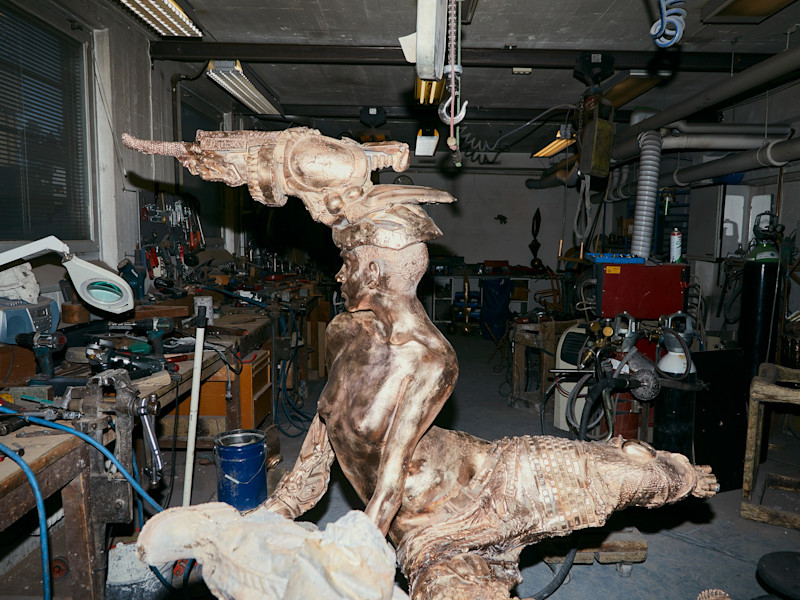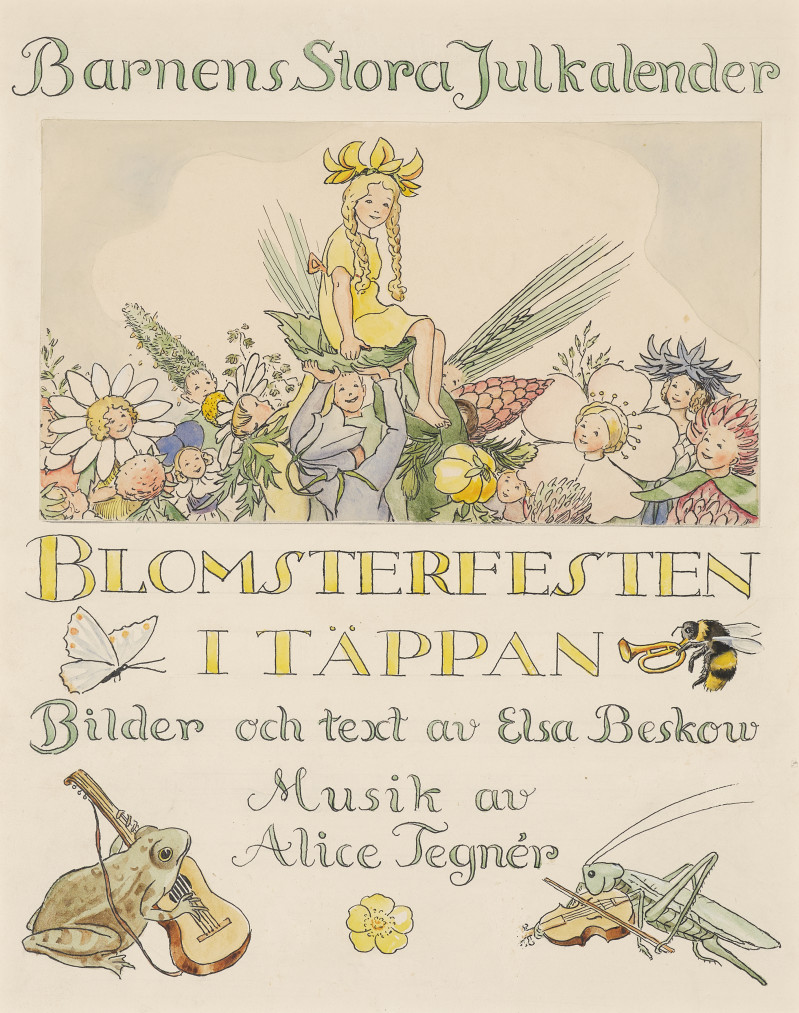Isak Hall Atlas essay by Pedro Westerdahl
Essay
December 1, 2022
- Pedro Westerdahl
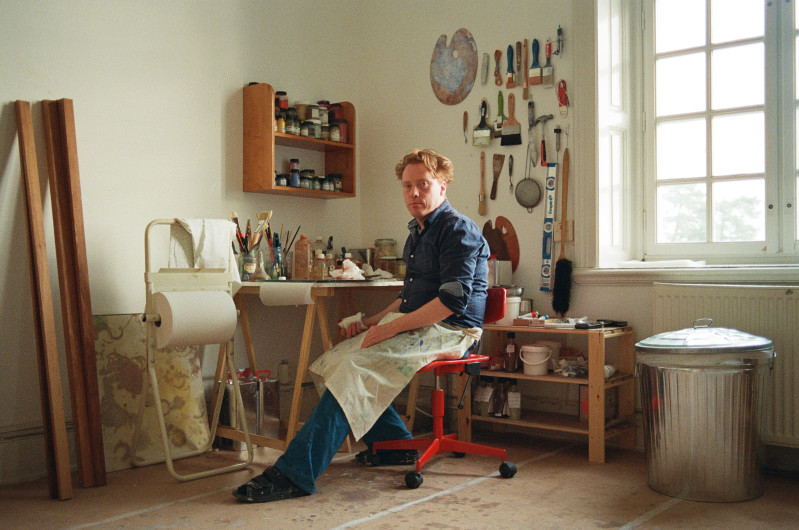
Isak Hall’s exhibition Atlas revolves around twelve all-new and peculiarly beautiful compositions, which have all been executed in the format of 146 x 114 cm. Their uniform size (we will soon be addressing how this came about) and outward execution give these twelve subjects an unstated, but vaguely implied connection: they are like separate pages, bound together in an ancient atlas. The individual compositions, however, each speak their own unique languages, which we viewers are free to experience as we “turn the pages” of (or move our gaze along) this monumental, wall-mounted atlas. Endless skies with burning celestial bodies are interleaved with expansive, seemingly deserted and arid landscapes towered over by the mountains or sand dunes that loom in the background. Here and there, we can also see bird’s-eye views of distant landscapes of branching rivers. Mysterious monoliths–hovering rock formations–tie these works in with the artist’s past production, such as the series Northern Transcendence.
These twelve pieces, as is customary for this artist’s works, express a deep, sincere love of painting as a form of expression. One important connecting thread here is a striving, or longing, to capture one of the most ephemeral of phenomena in this world: light. The depiction of light and its ungraspable essence is a recurring theme in Isak Hall’s artistic production. In Hall’s previous series, including Northern Transcendence and Tempelserien [The Temple Series], which were both featured in his 2020 exhibition Träden står ljust gröna [The Trees are Bright Green] at Bonniers konsthall, abstract shapes, which often seem to be glowing, are starkly contrasted against dark backgrounds. When viewing a work like Isenheim, for instance, the words of Renaissance philosopher and polymath Francis Bacon (1561–1626) readily come to mind: “In order for the light to shine so brightly, the darkness must be present.”
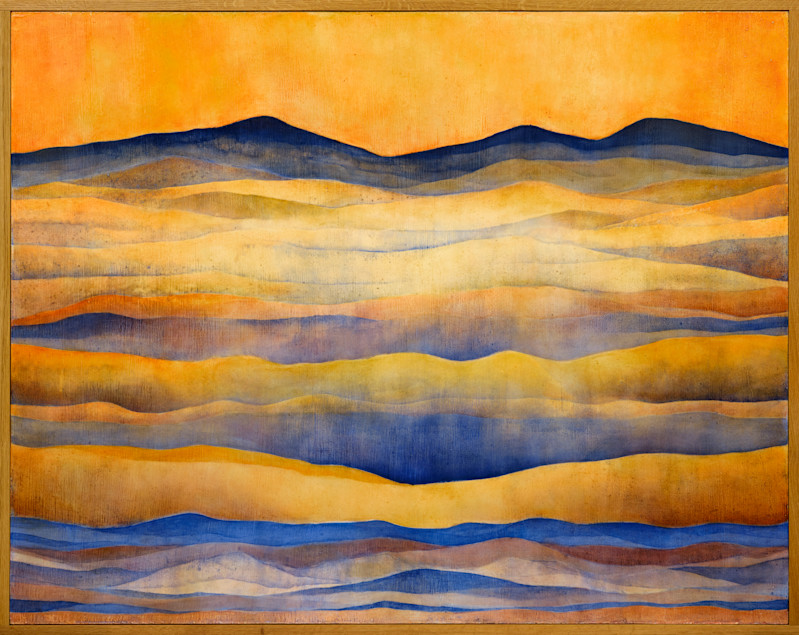
Isak Hall Untitled, 2022, Tempera och olja på pannå, 114 x 164 cm
Isak Hall himself is anything but unfamiliar with the cultural era of the Renaissance. In fact, his own masterful technique calls back to and departs from artistic methods from the very dawn of the modern era, around the turn of the 15th century. At this time, a disciplined and time-consuming approach to oil painting was favoured, as represented in North Europe by legendary artists like Jan van Eyck (c. 1380/90–1441) and Rogier van der Weyden (c. 1400–64). Their elegant and frequently highly detailed paintings were accomplished by the application of numerous layers of glazes over one another, which were alternated with layers of varnish to grant the compositions an incredible sense of depth. Hall recognised the virtues of this particular technique early on:
I’ve always taken an interest in crafts, and painting on panel is a rich tradition in oil painting. It’s difficult, on the one hand, because the works end up so heavy, but I think this is actually a positive, in that it gives you an entirely different light and depth, and the application of varnishes allows the pigments to be blended in a very particular way. These are methods that can be refined indefinitely, and in which you’re always learning, as each pigment behaves in its own particular way.
The fact that Hall, alongside the purely technical innovations made during the period, also takes inspiration more generally in the art of the late Medieval period and the Renaissance, is also deducible from the aforementioned Isenheim. The title of this painting from the Tempelserien series is obviously linked to the famous altarpiece made by Matthias Grünewald (1475/80–1528) for the Antonine order’s abbey in Issenheim, 1512–6. Hall has personally visited and seen the altarpiece, which is now kept in the collection of Musée Unterlinden in Colmar, Alsace, on several occasions.
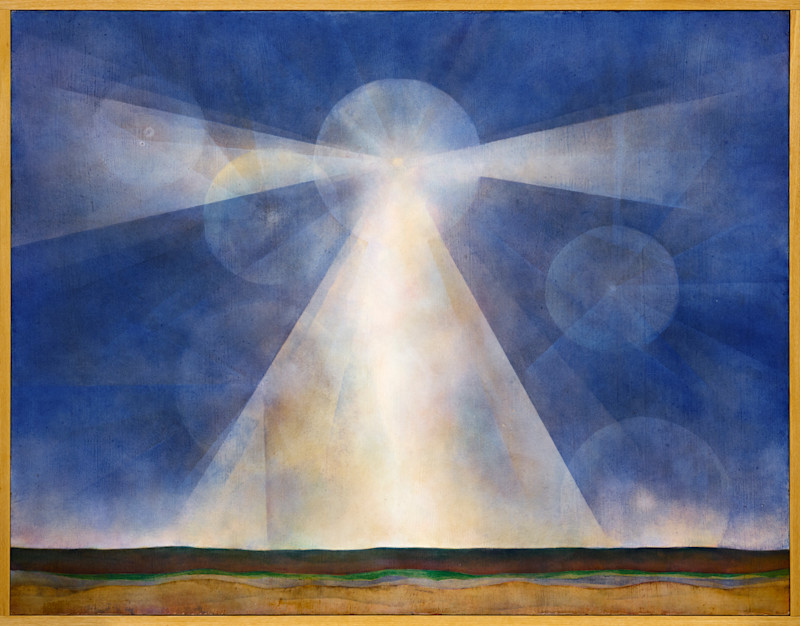
Isak Hall Untitled, 2022, Tempera och olja på pannå, 114 x 164 cm
The celebrated CFHILL exhibition Vädersolstavlorna [The Sundog Paintings] (20 May–4 June 2021) was also based on Hall’s passion for early painting. It presented works in which Hall’s inspirational point of departure was Vädersolstavlan [The Sundog Painting], a painting that is on display in Storkyrkan in Stockholm. The existing work is a copy made around the year 1636, based on an earlier original that was probably painted in 1535.
The four works, each measuring 162 x 196 cm, that were shown in the 2021 exhibition Vädersolstavlorna were Hall’s largest to date. The twelve slightly smaller fibreboard panels in this exhibition each measure 146 x 114 cm. While size may not generally be of much significance, in this particular case, it offers another clue to Hall’s most personal, but often rather ingenious, methods. Although late Medieval and Renaissance painting does serve as a recurring springboard for Hall, he doesn’t restrict himself to one-dimensional contexts–on the contrary, he is always gathering inspiration from all over. When Belgian surrealist René Magritte’s (1898–1967) famous painting L’empire des lumières [The Empire of Light] (1961) recently went under the hammer for a record-breaking price at Sotheby’s in London, many of us found ourselves admiring the work’s outstanding composition. Isak Hall was no exception. Interestingly, his main positive response to L’empire des lumières was in relation to its format and size (146 x 114 cm), which he decided to adopt for all twelve of these new panels.
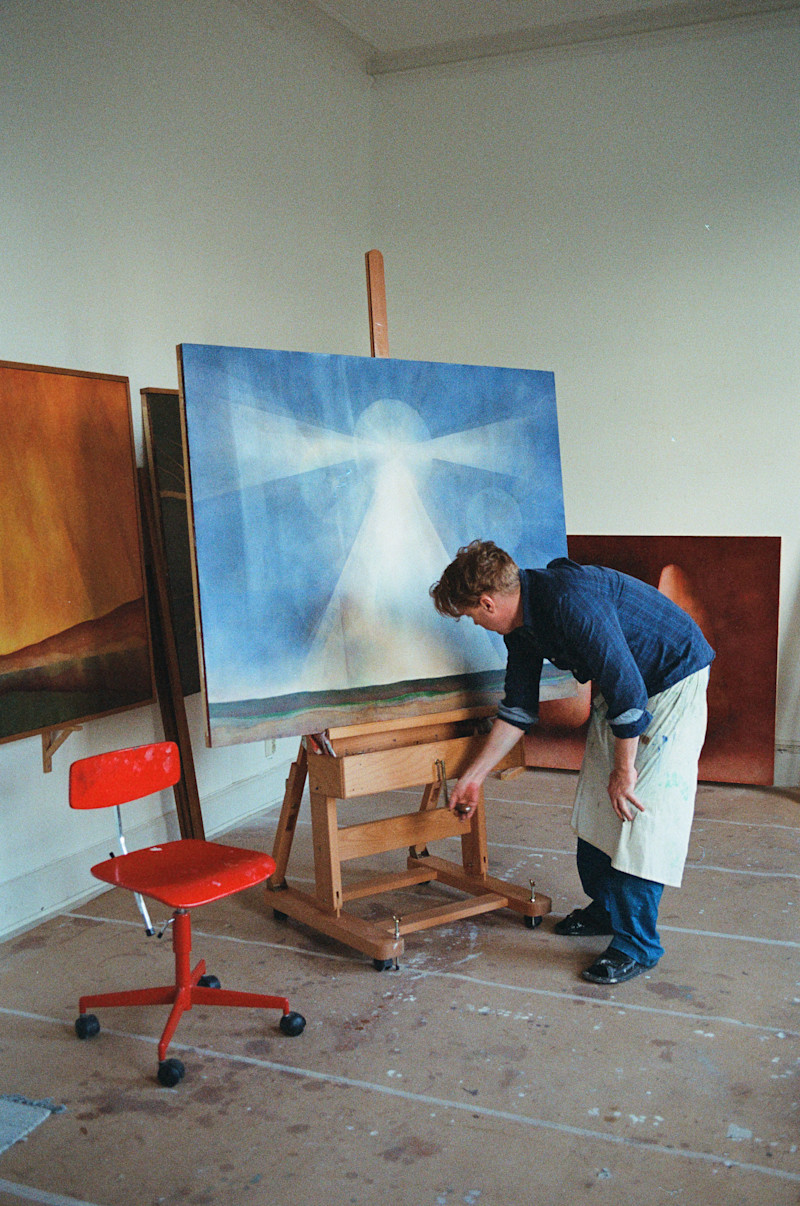
Isak Hall, in his studio, Uppsala
Magritte’s masterful painting from 1961 is based on the contrast between daylight and dusk. The same balance between light and dark has preoccupied Hall before, and still does, to some extent. Some of Hall’s compositions also seem to express a somewhat elegiacal undertone, which, again, appears most clearly when the works are compared to Magritte’s. This mood seems to encourage thoughtfulness in the viewer, as though a timeless yet distant, visionary, and barely graspable message were concealed between the thin layers of pigment that cover these solid panels. Possibly, this is a case of genius loci (the nature of the place)–but it could also all be in the mind. Interesting, though, in this context, is that these twelve compositions were created in an abandoned, desolate healthcare facility outside of Uppsala: Ulleråker’s hospital.
This was where one of the most famous, and also one of the most peculiar, of all Swedish portraits was made back in 1909: Richard Bergh’s (1858–1919) symbolist portrait of the poet Gustaf Fröding (1860–1911).
In issue 40 of Bizart, which was published in 2022, Johanna Uddén gives an account of her visit to Hall’s studio in Uppsala (where his work on these twelve pieces had just begun):
Last year, he was given a municipal arts grant, and today, he maintains a studio in the old hospital in Ulleråker. That’s where he meets me. In the large hall, which faces east, he has mounted twelve large fibreboard panels, which he is about to begin priming. “I’m preparing a new series of paintings for an exhibition at the CFHILL gallery in Stockholm this autumn.”
Hall goes on to explain how he achieves the characteristic depth and the glowing, almost supernatural, light his paintings are known for:
I’ve taken inspiration from older painting techniques: I prime with lime, and then I add tempera on top–it works very well over a lime primer. I paint in two tones of tempera–this is a classic technique called grisaille painting, that was used a lot back in the Renaissance. Gris actually means grey, which was the most common choice, but I use terra sienna or umber and a variety of whites. I then apply several layers of oil paints over the tempera. Some of these are thin glazes, while others will be thicker layers. Oil and tempera behave differently in light. Temperas seem to sort of bounce out of the light, while oil paints seem to absorb it. Another way of adding depth to a painting is to separate different layers of transparent pigments.
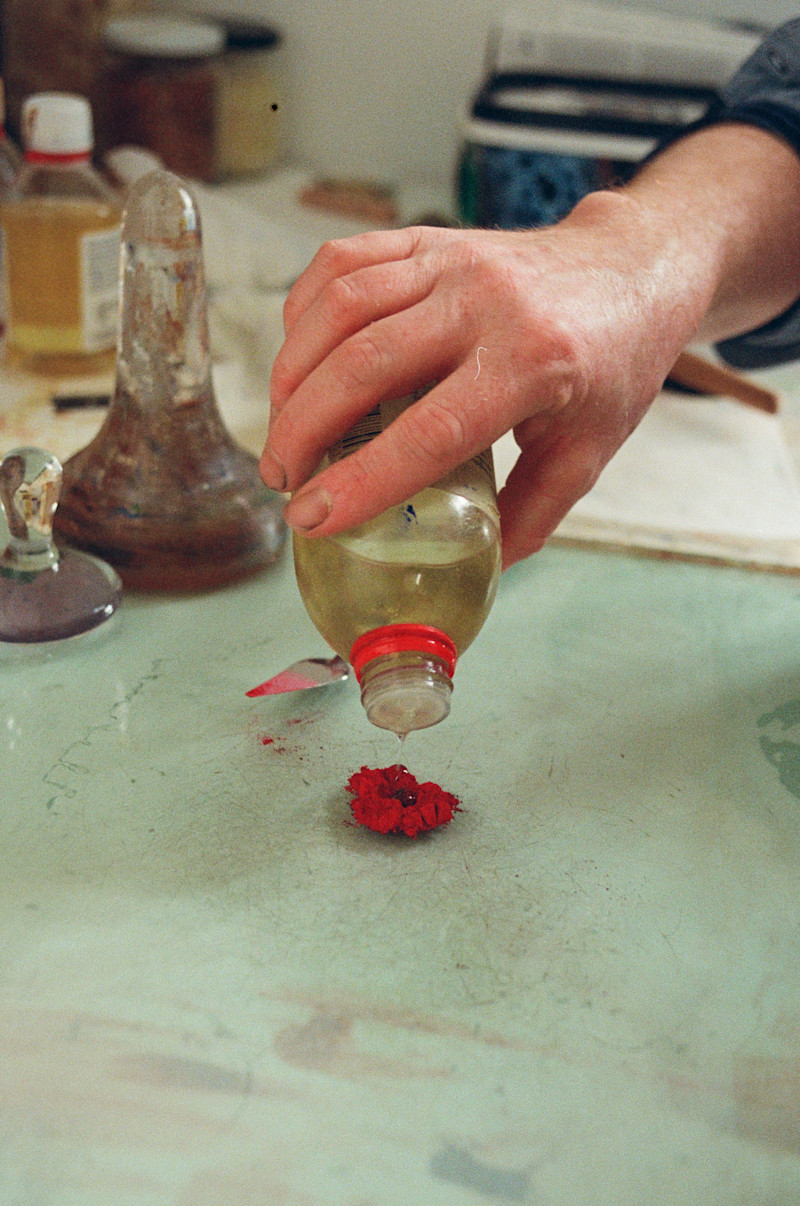
Isak Hall, in his studio, Uppsala
Speaking of pigments, Isak Hall invests an incredible deal of attention into these basic components. Significant here are exclusive mineral pigments, such as malachite and lapis lazuli, which Hall imports from various parts of the world. “Genuine materials lend the works authenticity. The paintings end up consisting of different components, from different places in the world. This creates a positive sense of exclusivity, which adds to the value and makes the paintings more durable.”
The mineral lapis lazuli has played a prominent role in art history for several millennia. Decorative objects made from this rock have been found in important stone-age grave sites in Pakistan, and the material was also used to make Tutankhamun’s (1341–23 B.C.) legendary golden funeral mask. Towards the close of the Medieval era, lapis lazuli began to be exported to Europe, where it was ground into a powder to make ultramarine, the finest and most expensive of all blue pigments. Ultramarine was used by some of the most important Renaissance and Baroque artists, including Masaccio (1401–28), Titian (1488/90–1576) and Vermeer (1632–75). This colour was often reserved for the clothes worn by the central figures in their paintings, particularly the Virgin Mary.
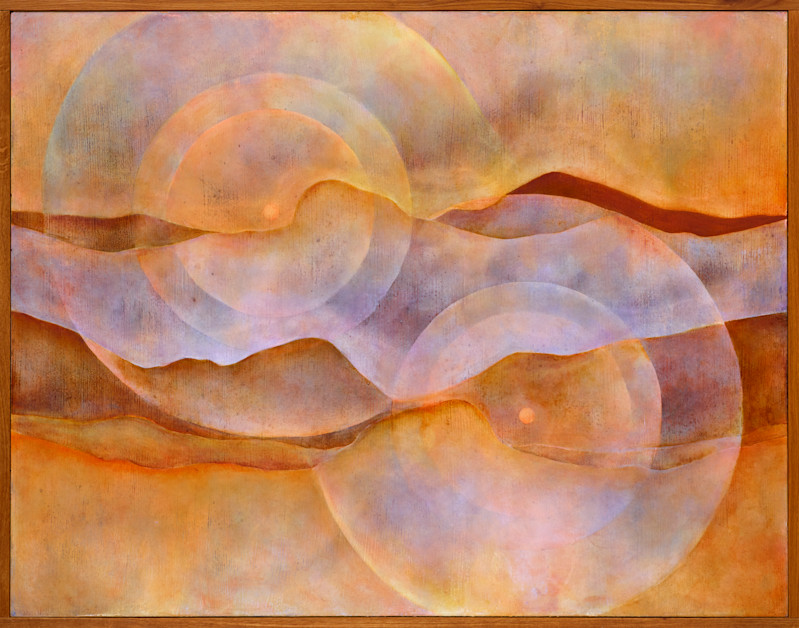
Isak Hall Untitled, 2022, Tempera och olja på pannå, 114 x 164 cm
Isak Hall uses these exclusive pigments with the same focused reverence and deliberate intentions that his aforementioned predecessors held for it. However, Hall foregoes figurative, genre-dependent, and historical conduits (such as the Virgin Mary), choosing rather to address the ungraspable infinity of creation more immediately. Hall’s paintings consist of unconventional, highly personal landscapes characterised by glowing light and internal depth. Viewing Hall’s works is an opportunity to appreciate further aspects of the universe, constrained only by the expressive potential of egg tempera, ochres and earth pigments, and malachite and lapis lazuli. In closing, I’d like to return once more to René Magritte.
While Isak Hall found himself captivated by the size and format of L’empire des lumières, I found myself preoccupied with the painting’s title and message when I saw it at Musée Magritte in Brussels (where it was held 2009–20). Faced by these twelve, pregnant panels, which light up the gallery and surround the viewer, like the lime murals in Swedish Medieval churches, I find myself inevitably returning to the title of Magritte’s masterpiece: L’empire des lumières [The Empire of Light]. From this ungraspable and distant, yet ever-present “empire of light”, Isak Hall has sent us twelve unfathomably beautiful postcards. If bound together into a single Atlas, or exhibited in a single gallery, these postcards can be viewed as maps from a unique but simultaneously universal empire, in which light reigns supreme for the benefit of all.
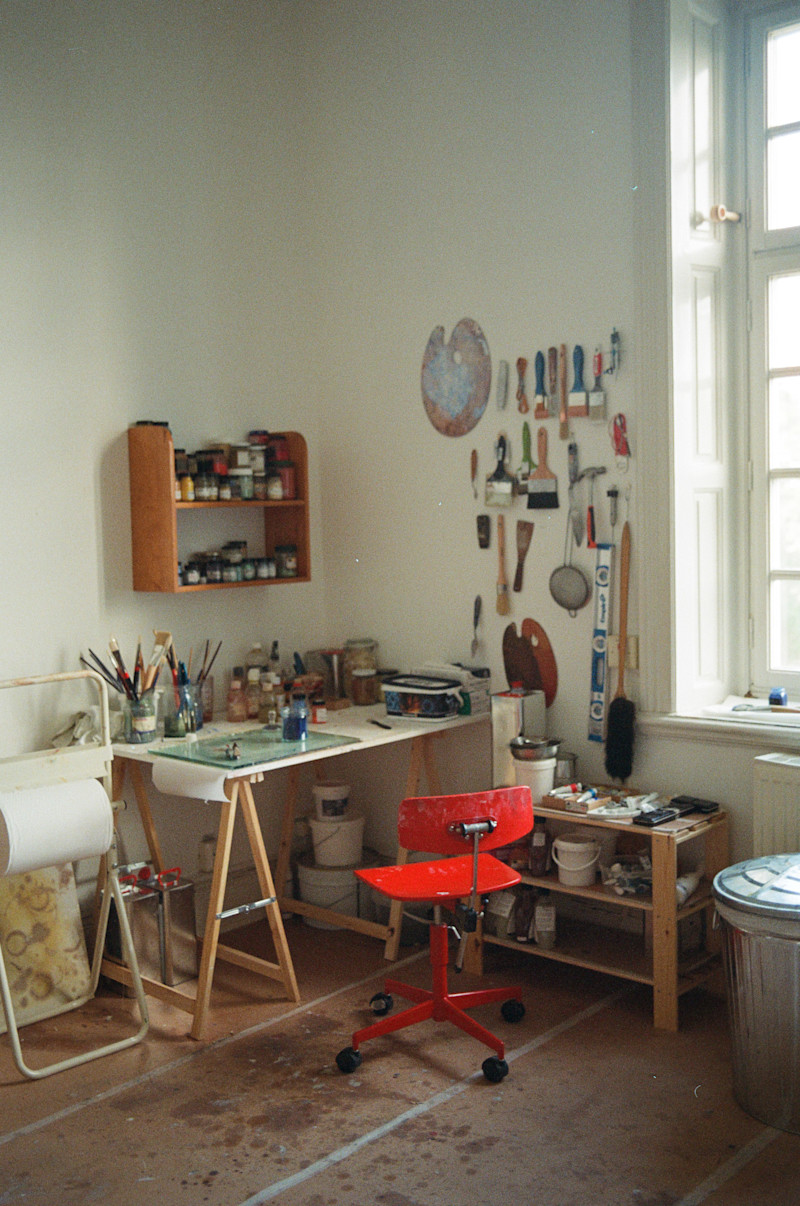
Isak Hall, in his studio, Uppsala
